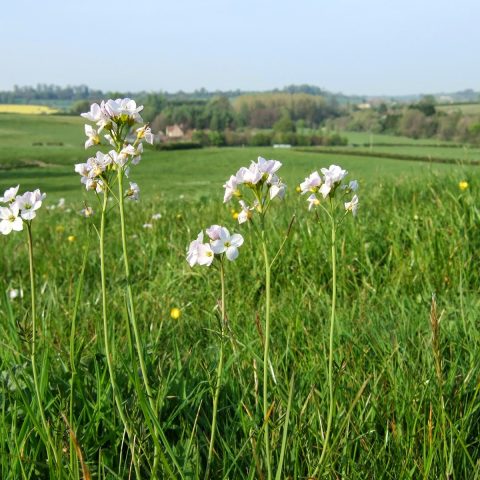Welsh Water's story
A semi-ancient woodland that was neglected for decades is being regenerated by Welsh Water, with help from members of the north Cardiff community.
Our Community Woodland Project, funded by the Welsh Government Community Woodlands initiative and The National Lottery Heritage Fund, aims to boost the biodiversity and social value of woodland framing Welsh Water's 110-acre Llanishen and Lisvane reservoir site.
Launched in 2019, it complements Welsh Water's Enabling Natural Resources and Well-being (ENRaW) project, which aims to transform the whole site into a hub for health and wellbeing while protecting and enhancing its ecology – in line with the Well-being of Future Generations (Wales) Act 2015.
When Welsh Water acquired the reservoir site in 2016, the woodlands had been neglected for many years and were unmanaged, with overgrowth, invasive species, fly tipping and access issues.
Cherry laurel had taken over one woodland and needed to be removed to allow regeneration. Some neighbours had extended their gardens into the woods and planted things inappropriate for a semi-ancient natural woodland. Others were dumping their waste there. Despite this, the woodlands' importance in connecting Cardiff's green spaces via the city's extensive Nant Fawr trail was clear, as was their ecological and wellbeing value.
To start, a tree safety survey identified unsafe or diseased trees. We then created a woodland management plan with Wildlife Trust support, which identified priorities - including restoring a historic fish pond that could help various species thrive.
Set to complete in May 2022, our woodlands project will create a learning zone, only accessible to schools and wellbeing groups, along with an outdoor classroom. A nature trail and ranger-led tours will inform visitors of the site's history and ecological value, while natural play installations from felled trees will encourage exploration of the woodlands.
Spatial and temporal zoning will safeguard areas of greatest sensitivity, including the location of a large badger set.
Welsh Water initially expected the regeneration to take decades, relying on the work of community volunteers. But a cash injection from the National Lottery Heritage Fund and the Welsh Government, meant contractors could do the more significant 'capital works' in early 2022, such as the removal of cherry laurel, the pond restoration, creation of paths and nature trail.
Volunteering opportunities for conservation management are planned. A supervised volunteers training programme will contribute to the woodlands' restoration by building people's capacity and understanding to care for the area in environmentally appropriate ways, while enabling them to learn new skills and connect with others and nature in a safe environment.
We are also exploring community payback opportunities with Cardiff and Vale probation services.
Useful learnings from Welsh Water
Ultimately, we are a water utility company, not a wildlife organisation, so we've drawn from, and appreciated, the expertise and support of other organisations on this journey.
We have worked with the Wildlife Trust of South and South West Wales to develop our woodland management plan, for example. Llais y Goedwig, a network organisation connecting community woodlands in Wales, has generously shared its learnings with us and offered to train and engage volunteers on community woodland because of its expertise in this area.
We've learned about the challenges faced in tackling invasive non-native species sustainably from the Sustainable Stitch in Time project. And when it came to developing recreational play facilities using the timber on site, Play Wales' support and guidance has been invaluable.
It's impossible to overstate the value of engaging the local community in projects of this kind, too. The local Reservoir Action Group campaigned for a decade to save the Lisvane and Llanishen reservoirs from development. When you have a group of local people who care so much about a site's survival and want it to thrive, working closely with them is a must. Their support setting up our first ever 'Friends of' group has been crucial in maintaining momentum and progress.
There have been challenges too, the Covid-19 pandemic being the most obvious, but significant. As this woodland project is reliant on volunteers, restrictions on the number of people who can meet and social distancing requirements have impacted our ability to implement face-to-face activities. Around 130 people registered to become 'Friends of' the woodlands, expressing an interest in caring for this site in the future, which is wonderful, but it has been challenging for them to remotely organise themselves.
There have also been surprises that have reminded us of the importance of keeping a flexible approach and open mind. While working on this community woodland project, an unexpected opportunity arose to acquire a third woodland area, which could provide a gateway between our site and a major residential development planned immediately north of our woodlands. We have requested a developer contribution toward the cost of bringing that third woodland into active management. We will also be seeking other funding to support work that enables public access and community engagement and ownership.
The evolution of our partnership with the education sector has also been unexpected but wonderful. Cardiff Metropolitan University established a working group for our sister ENRaW project, spearheaded by a professor local to the site who had an interest in social prescribing. That working group has presented so many additional opportunities for the woodlands to be used for learning - from formal education at primary level to adult learning. It is a sensitive site, there's never been public access, so we are embracing opportunities to educate people on its ecology and foster respect for it.
Welsh Water's metrics
We will evaluate the economic, environmental and wellbeing impact using a SROI model.
Visitor counters will measure footfall while seasonal visitor surveys along with on-site QR code surveys will capture impact.
Our annual wildlife and environmental surveys, including of bird and fungi species, will help us measure our environmental progress.
To measure wellbeing, we will use the Warwick Edinburgh Mental Wellbeing Scale – a questionnaire producing a single score.






